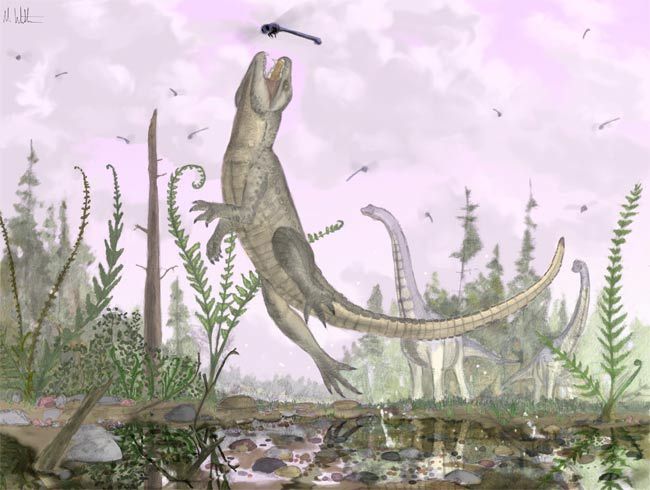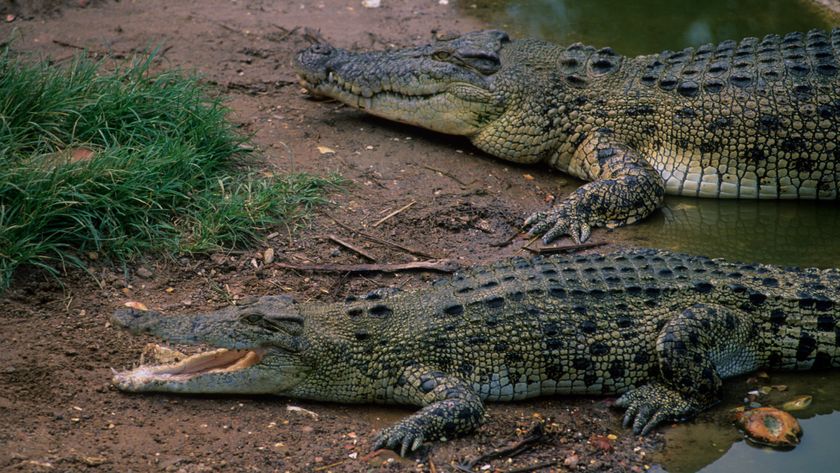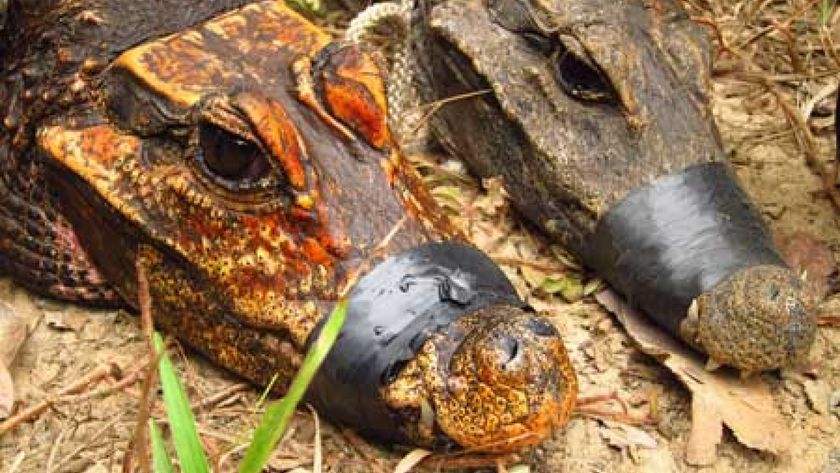Ancient Cat-Size Croc Had Armored Tail

A cat-size crocodile sporting a tail covered in armored plates was not as fierce as its relatives today. Rather, the animal foraged for insects and small mammals 105 million years ago along what is now a riverbank in Tanzania.
"Its head would fit in the palm of your hand," said Patrick O'Connor, associate professor of anatomy at the Ohio University College of Osteopathic Medicine.
O'Connor and an international team discovered a complete skeleton of the crocodile in 2008 and, more recently, remains from seven others of the same species.
The largely unarmored body and slender limbs suggest Pakasuchus kapilimai, as the crocodile has been named, was relatively agile, actively searching for food on land, unlike today's water-dwelling crocs. The reptile also sported teeth fit for a mammal, not a crocodile as we know it.
"If you only looked at the teeth, you wouldn't think this was a crocodile. You would wonder what kind of strange mammal or mammal-like reptile it is," O'Connor said.
The discovery is described in the Aug. 5 issue of the journal Nature.
Teeth built for 'chewing'
Sign up for the Live Science daily newsletter now
Get the world’s most fascinating discoveries delivered straight to your inbox.
The fossil skull was originally encased in hard, red sandstone, with the jaws tightly closed, so the team relied on CT scans to get at details. They also animated the resulting images to see how the teeth fit together and how the jaw may have moved.
They found the teeth had shearing edges for processing food and there was a near-perfect fit between the upper and lower rear teeth.
The teeth suggest the animal could process food similarly to how mammals do it. That is, rather than the using simple conical teeth to seize and tear prey, then swallowing large chunks of flesh like today's crocodiles, this animal may have done something similar to "chewing." (The ability to chew is reserved for mammals, the researchers pointed out Monday in a webcast briefing on the discovery.)
Behaving like mammals
Due to its teeth, and possibly its small stature, the creature chose a different diet from its distant relatives (today's crocodiles) and thus occupied a different ecological niche, the researchers suspect.
When this animal was alive, the southern continents were joined together as the supercontinent Gondwana. Relatively few Cretaceous-age mammals have been recovered from this part of the world, the researchers say.
The landscape was probably dominated by a large river with multiple, crisscrossing channels separated by vegetated floodplains, said study researcher Eric Roberts, an assistant professor of geology at James Cook University.
O'Connor said Notosuchian crocodyliforms like Pakasuchus may have taken up residence in a typically mammalian niche. Based on other fossils discovered in the area, Pakasuchus is likely to have lived alongside large, plant-eating sauropods and predatory theropod dinosaurs, other types of crocodiles, turtles and various kinds of fish.
"We suspect that notosuchians were very successful in the Southern Hemisphere because they were exploiting a certain ecological niche, one in which they were able to successfully compete with other small-bodied, terrestrial animals," O'Connor said. "This is an environment that was quite different from what we typically think of for crocodiles."
The research was supported by the National Science Foundation (NSF), National Geographic Society, University of the Witwatersrand, Michigan State University Office of Research and Graduate Studies, and Ohio University's College of Osteopathic Medicine and Office of Research and Sponsored Programs.
- Dangers in the Deep: 10 Scariest Sea Creatures
- What's the Difference Between a Crocodile and an Alligator?
- 10 Amazing Things You Didn't Know About Animals
Jeanna Bryner is managing editor of Scientific American. Previously she was editor in chief of Live Science and, prior to that, an editor at Scholastic's Science World magazine. Bryner has an English degree from Salisbury University, a master's degree in biogeochemistry and environmental sciences from the University of Maryland and a graduate science journalism degree from New York University. She has worked as a biologist in Florida, where she monitored wetlands and did field surveys for endangered species, including the gorgeous Florida Scrub Jay. She also received an ocean sciences journalism fellowship from the Woods Hole Oceanographic Institution. She is a firm believer that science is for everyone and that just about everything can be viewed through the lens of science.












